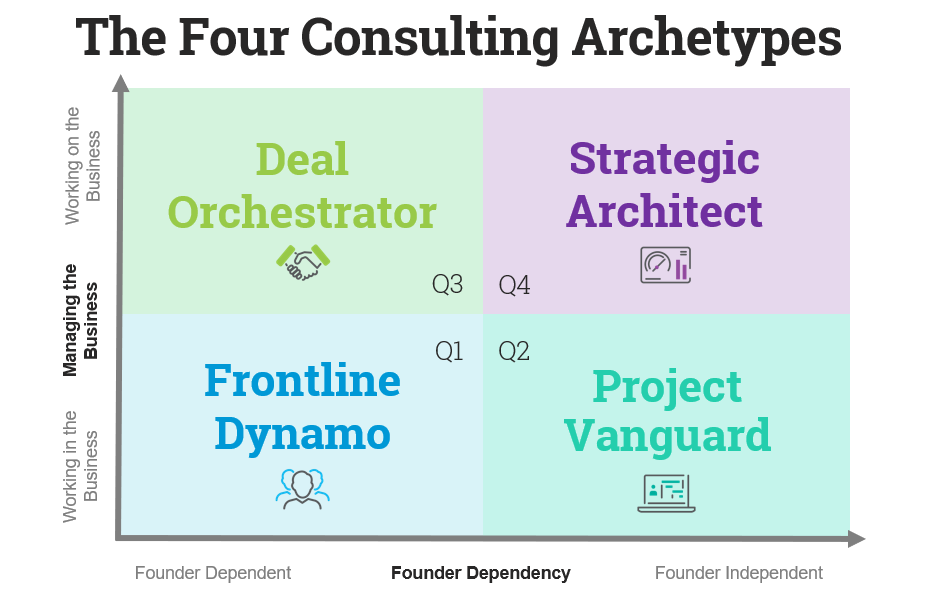How to Break Your Consultancy Out of the Service Delivery Mindset

Guest Author: Luk Smeyers, Consulting Expert & the Founder of The Visible Authority
Our new blog series with consulting expert Luk Smeyers from The Visible Authority will feature three areas consulting leaders should focus on today to help their firms grow, improve profitability and become more efficient. Part one focuses on breaking out of the service delivery mindset.
Are You Trapped in the Service Delivery Mindset?
Most consulting ventures start with a handful of talented founders with specific expertise and a strong service delivery mindset. But here's the rub: this approach is a double-edged sword. While this focus fuels the initial growth, it can lead to stagnation if the owners don't evolve. Let's dive into the world of consultancies and explore how to balance these roles for sustainable growth.
Have you ever asked yourself if you're truly leading your consultancy or merely surviving in the trenches? Through years of advising consultancy boutiques, I've discovered that the answer lies not only in the firm's portfolio, market position, or the expertise it offers. Instead, it's deeply rooted in the co-founders' or co-owner team's unique profiles and dynamics. As a trusted advisor to boutique consultancies, I’ve noticed too many owners and partners are overly involved in service delivery. It's the comfort zone, the known territory, the familiar path. But as the business grows, this one-sided focus can lead to a growth plateau, strategic myopia, succession crises, and even a lack of financial oversight.
Throughout my journey, I've observed that the roles founders and owners play within small consultancies can make or break the business. Often unnoticed yet supremely influential, they act as silent conductors, guiding the destiny of the consultancy. From the frontline dynamos who tirelessly immerse themselves in project execution to the consulting entrepreneurs who deftly conduct the strategic symphony from a distance, each archetype brings a unique power play to the table. My observations led me to develop a comprehensive framework delineating four unique quadrants, each representing a critical aspect of leadership within a consultancy. In this article, I pulled from my years of experience to dissect these crucial characters.
The Four Leadership Archetypes
These quadrants aren't merely theoretical constructs but living, breathing aspects of the business, playing out daily in real-world scenarios. By understanding these quadrants, my clients are able to identify their leadership teams' inherent strengths and potential pitfalls, allowing them to craft a more balanced and effective approach to service delivery and running the business.
Let me walk you through these four quadrants: Frontline Dynamo, Project Vanguard, Deal Orchestrator, and Strategic Architect.
The X-axis, Founder Dependency
The X-axis reflects the degree to which a consultancy's operations and success rely on its founders. On one end, you have consultancies that are heavily founder-dependent, meaning they lean heavily on the personal expertise, reputation, and relationships of the founders for service delivery. This reliance can be limiting as growth will often be tied directly to the capacity and capability of the founder(s). Conversely, some consultancies have successfully transitioned to being founder-independent. These firms have systems, processes, and teams that operate effectively even without the founder, thus enabling scalable growth.
The Y-axis, Managing The Business
The Y-axis denotes the leaders' involvement in the consultancy's everyday operations versus strategic growth and future planning. At the lower end, leadership is immersed in the daily grind, handling the nuts and bolts of the business. While this can ensure quality and immediate problem-solving, it can also restrict the strategic view needed for long-term growth. On the higher end, leadership focuses more on business strategy, future planning, and creating expansion opportunities, thus ensuring the consultancy's longevity and sustainable growth.
Both axes serve as a gauge to help consultancy owners understand where they currently stand and how they might need to adapt for future success.
The Triad of Consulting Leadership: 3 Focus Area’s to Improve Efficiency & Profitability for Your Firm
w/ Consulting Expert Luk Smeyers
Quadrant 1 - The Frontline Dynamo
This founder archetype has a tremendous passion for service delivery and client work. They are deeply involved in operational execution, and they love it. They don't bear the responsibility of winning new contracts. Still, they are the primary contact for clients, establishing and nurturing first-line relationships in the trenches of the consulting work, in which they are directly involved most of their time.
Characteristics of the Frontline Dynamo:
- High client involvement
- Hands-on execution
- Limited scalability
- Operational focus
- Strong technical skills
The Frontline Dynamo archetype is common in the early stages of a boutique consultancy. While this archetype allows the founder to maintain control and ensure high-quality service, it may limit the firm's growth potential due to scalability issues. Over time, founders must evolve into other archetypes to foster scalability and firm growth.
Quadrant 2 - The Project Vanguard
This founder archetype is an operational powerhouse, deeply involved in managing the delivery of the consultancy's projects and services. They independently thrive in project management roles, ensuring the effective execution of projects and the satisfaction of clients. However, they usually have little involvement in sales or strategic planning and might show disinterest in financials.
Characteristics of the Project Vanguard:
- Operational Excellence
- Limited Involvement in Selling
- Project Coordination Focus
- Team Management
- Disinterest in the consultancy's consolidated financials (but managing project financials)
The Project Vanguard archetype is vital for the successful execution of projects in a boutique consultancy. They bring a wealth of operational expertise and vital project and team management skills. However, the firm might struggle with growth and financial management if they are the only leader. Having a co-founder or leader who can handle the business development, financials, and strategic planning complements the Project Vanguard's strengths and creates a more balanced leadership.
Quadrant 3 - The Deal Orchestrator
This founder archetype excels in securing new business. They are sales-oriented individuals, often possessing charismatic personas and a knack for creating meaningful relationships at C-level, which enables them to attract new clients, secure contracts, and manage the key accounts of the consultancy. The Deal Orchestrator loves to speak at conferences, and they are master networkers who effortlessly turn casual conversations into promising business opportunities.
Characteristics of the Deal Orchestrator
- Inherent rainmakers & key account leaders
- People connector
- Intuitive opportunity spotter
- Delegation of execution
- Selective financial monitoring
In essence, the Deal Orchestrator is a driving force in the growth stages of a boutique consultancy. They leverage their selling prowess and strategic insights to shape the firm's direction and ensure its growth. However, their relative disinterest in operational and financial details could leave them less informed about the firm's performance beyond sales, necessitating a strong team to manage these areas effectively.
Quadrant 4 - The Strategic Architect
This founder archetype is typically not involved in daily selling or the operational execution of projects. Instead, they focus on the strategic growth and development of the consultancy. They are forward-thinkers and visionaries who steer the course of the firm's future while allowing others to manage the execution and sales.
Characteristics of the Strategic Architect
- Strategic visionary
- Delegation of sales and operations
- Business development focus
- Financial leadership
- Service offering design
- Team development and mentorship
The Strategic Architect archetype is crucial for driving a consultancy's long-term growth and sustainability. They bring strategic vision and business development focus that can lead a consultancy to new heights. However, a consultancy that only consists of this archetype could face challenges in sales and operational execution.
Conclusion
Use these quadrants to shed light on the composition of your leadership team. They can help you identify gaps or overconcentration in certain in certain skills / archetypes. Each of these archetypes brings a unique set of strengths to a firm. However, it's crucial to remember that these archetypes are not black and white – finding someone who fits perfectly into one category is rare. Most individuals embody characteristics from multiple archetypes.
A balanced but well-considered mix of these traits drives success in a consultancy leadership team. As the team grows, it's important to focus less on their expertise and service delivery capabilities and more on this balance. By recognizing the value each archetype brings and fostering a team that encapsulates aspects of them all, the stage is set for robust and adaptable leadership, ultimately driving the success of your consultancy.
About the Author
Luk Smeyers is a revered consulting thought leader, blogger, author, and speaker. He is the Founder of The Visible Authority, where he helps mid-sized consultancy firms transition from a reactive approach to a more proactive and organized one that supports long-term growth and profitability. You can see more of Luk in our new webinar: The Triad of Consulting Leadership: 3 Focus Area’s to Improve Efficiency & Profitability for Your Firm.

Deltek Project Nation Newsletter
Subscribe to receive the latest news and best practices across a range of relevant topics and industries.

 Se Connecter
Se Connecter












